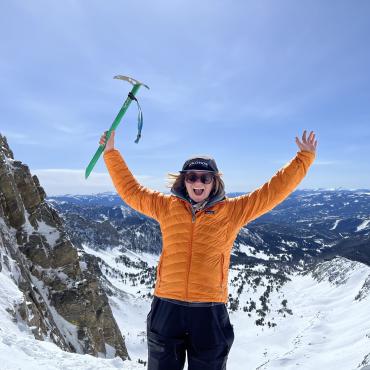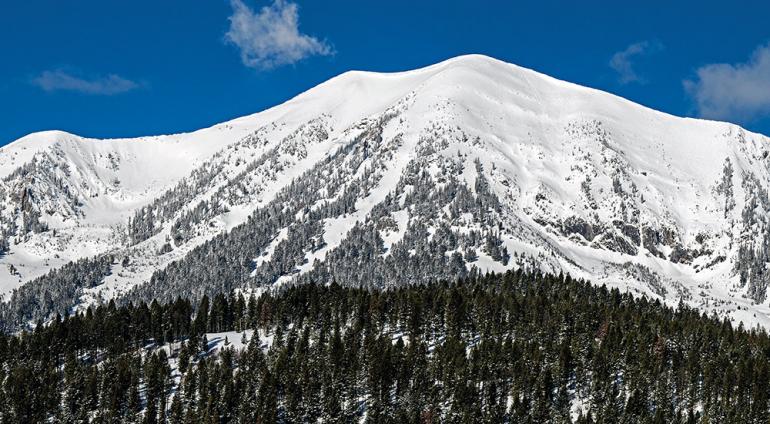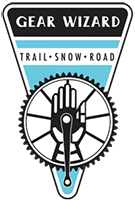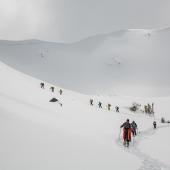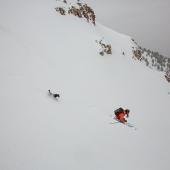To Ski or Not to Ski?
Taking precautions on Saddle Peak.
It was an epic winter day: the sun was shining, the sky was blue, and the snow was soft. My friends and I unloaded from Slushman’s, did the awkward skate-ski traverse along the Ridge, and began our hike up Saddle Peak. A 15-minute bootpack led us to a nearly untouched powder field we’d eyed from the lift. I clicked on my skis, tapped my poles together, and dropped into cold-smoke bliss. It was one of the best ski runs of my life.
That was my freshman year at MSU, and my freshman year at Bridger Bowl. What we did that day wasn’t out of the ordinary, but after gaining a few more years of experience, I realize how foolish it was. We skied off Saddle Peak as if it were just another part of the ski area, taking no precautions for avalanche safety. I was in way over my head, without even realizing it. Any one of us could’ve gotten seriously injured, or killed. Now, as a more experienced skier and avalanche educator, I look back and scratch my head... Why did I treat that terrain with such little caution? Why the f#&@ did I ski that?
Saddle Peak—the prominent twin summit just south of Bridger Bowl—is appealing for good reason. The terrain holds consistently good snow and beckons expert skiers with its continuously steep pitch. It’s easy to access from the top of Slushman’s and spits you right back at the bottom of the lift after your run. At the same time, Saddle is an unforgiving backcountry mountain face. With no avalanche mitigation, its snowpack naturally builds into a stack of dense slabs and weak facets. A 200-foot cliff looms at its base that isn’t clearly visible from above. And if something goes wrong, you’re on your own.
How did we, and so many others, mistake this peak for something other than what it truly was? MSU snow scientists John Sykes and Jordy Hendricks have been studying skier demographics on Saddle through a combination of surveys, GPS tracking, and time-lapse photography. What they’ve found is an emerging pattern of “overreliance on familiarity” among Saddle-Peak skiers. “Familiarity,” in the context of avalanche safety, is a tendency for humans to naturally perceive familiar areas as “safer” than unfamiliar areas. But isn’t it safer if I know what to look out for? Well, therein lies the problem: if you know what to look out for, you won’t look out for what you don’t know. Ever left a trailhead without bear spray because you’ve been there a hundred times before and never seen a bear? Same premise. You’re not any less likely to have an encounter, you just don’t perceive the danger through your familiarity bias.
Just because you get off the Slushman's lift with a beacon doesn't mean you're good to go.
How does this play out between Bridger Bowl and Saddle Peak? Sykes’ and Hendricks’ observations speak for themselves. More solo skiers were seen on Saddle Peak than in traditionally-accessed backcountry areas. Skiers on Saddle with less formal avalanche training tended to stick closer to the ropeline, despite this specific zone’s exposure to massive cliffs below. Surveys indicated that one in five skiers on Saddle Peak were under the false impression that the terrain received avalanche control from Bridger Ski Patrol, despite a sign clearly noting otherwise at the backcountry gate. And only two out of every three skiers on Saddle Peak actually knew the avy danger forecasted on that given day, despite several postings at Bridger Bowl, online, and on social media. Clearly, something isn’t clicking with skiers who decide to cross that boundary.
|
|
On a typical backcountry tour, skiers constantly assess snowpack, look for signs of instability, and gather evidence to ski or not to ski. But these precautions aren’t typically—if ever—practiced when skiing in-bounds. The Slushman’s lift requires skiers to carry a beacon, but as far as avy gear goes, that’s it. “Just because you get on the Slushman’s lift with a beacon doesn’t mean you’re good to go,” says Alex Marienthal of the Gallatin National Forest Avalanche Center. He describes skiing Saddle Peak as no different—if not more dangerous—than other backcountry options in the area. “Treat it like you’re going on a tour to Beehive Basin or Mount Blackmore,” he says. “Know where the resort boundaries are and be intentional when you cross them.”
That day on Saddle Peak—that perfect ski run on that perfect day—was incredibly risky. It’s terrifying to think how clouded my judgment was by the proximity, accessibility, and relative familiarity of Saddle Peak. The terrain is so close to the boundary and so similar to the patrolled Ridge terrain I had skied time and time before, I figured, how dangerous could it be? Well, Saddle Peak is the backcountry and is dangerous—and that day, I didn’t see it. I wasn’t thinking like a backcountry skier, and I got lucky. So I offer this to everyone: next time you contemplate crossing the resort boundary, be prepared, know before you go, and understand the risk—it might save your life.

